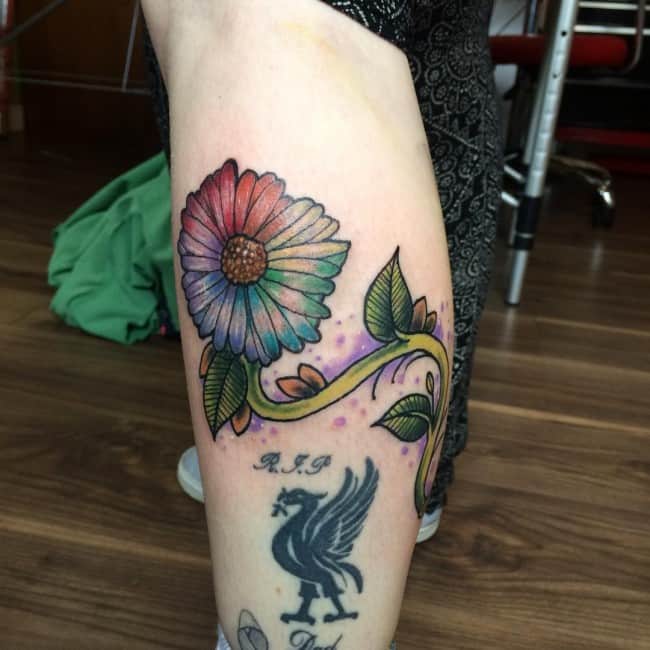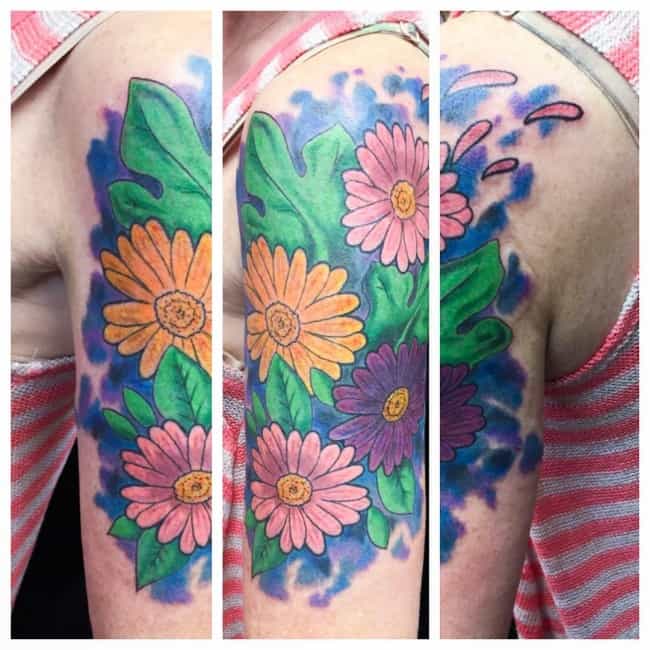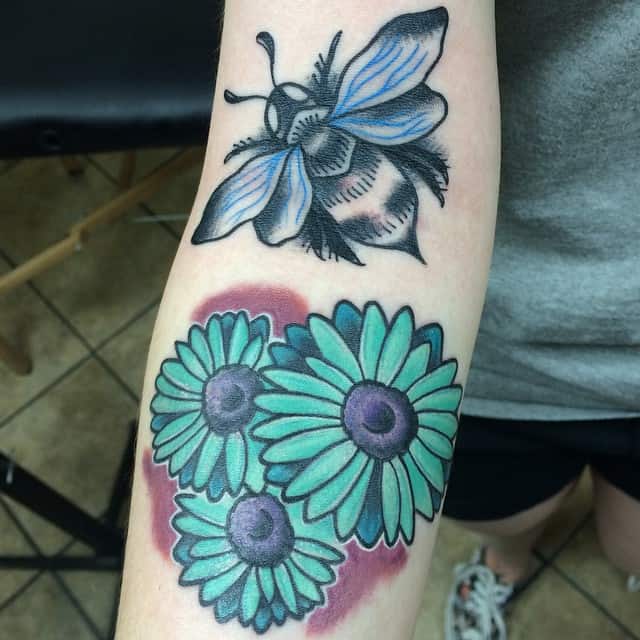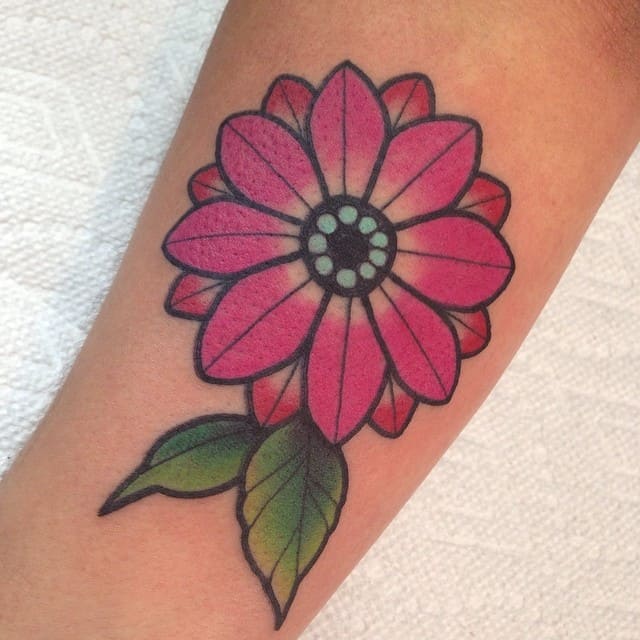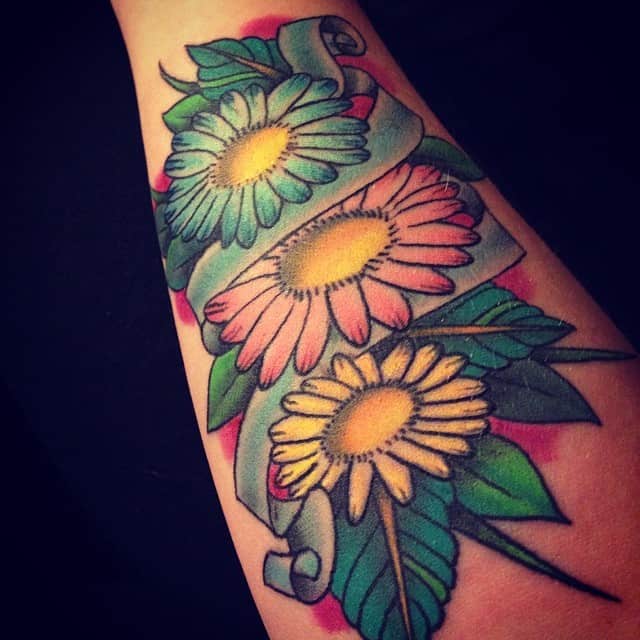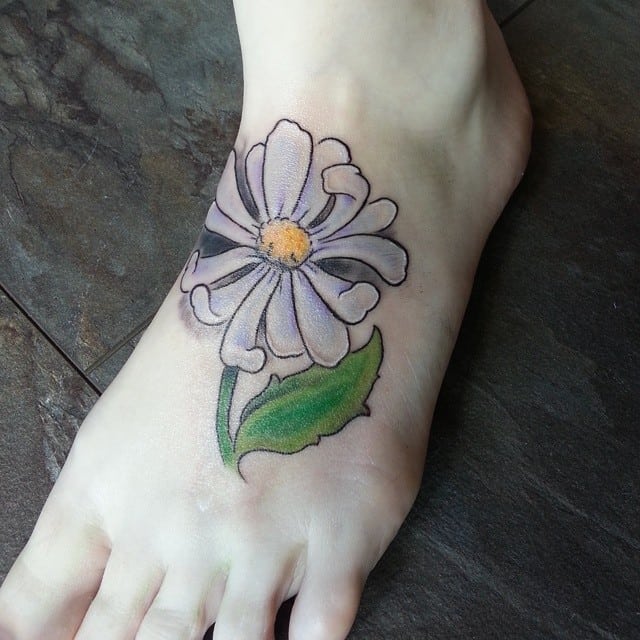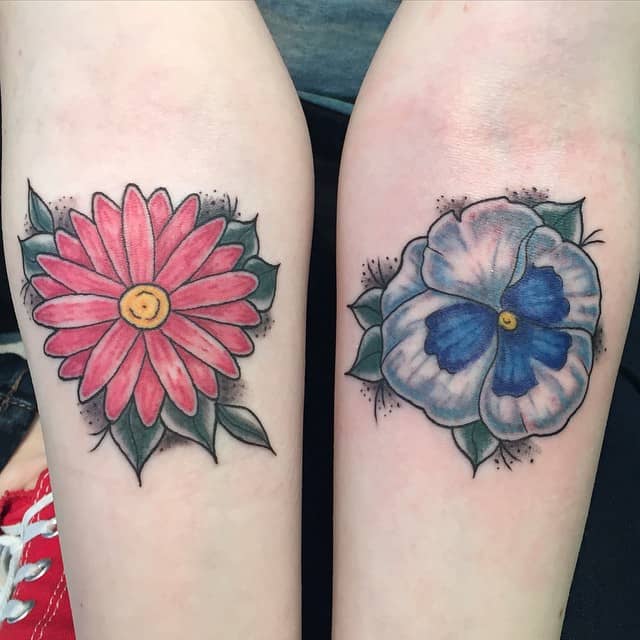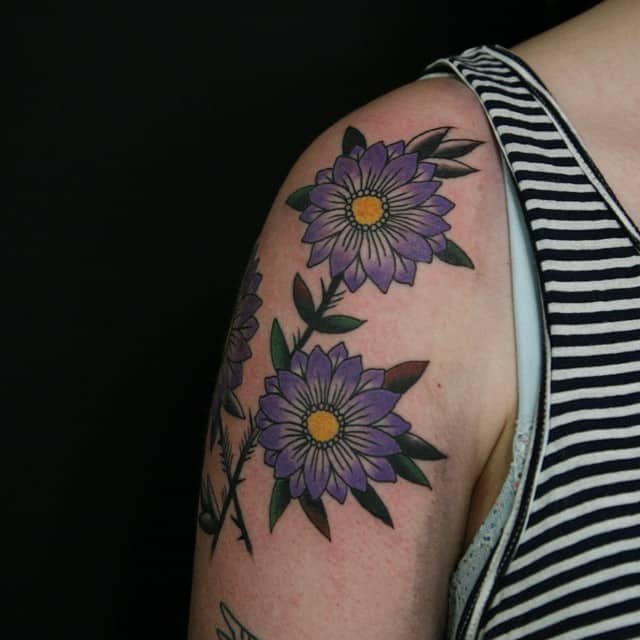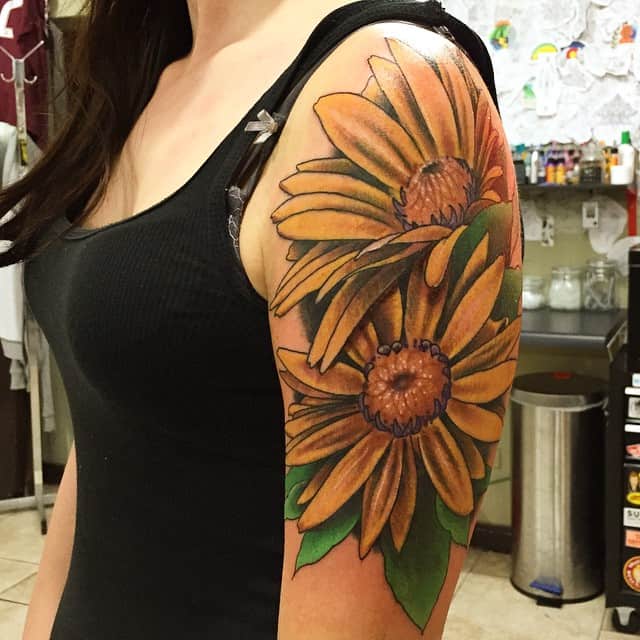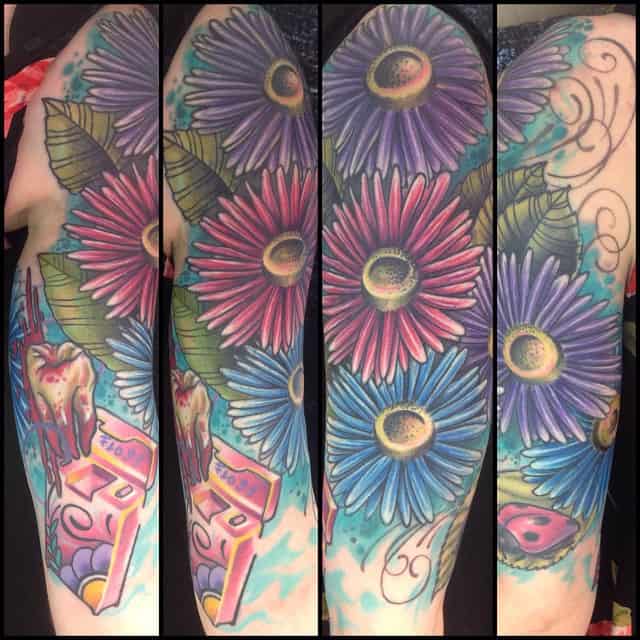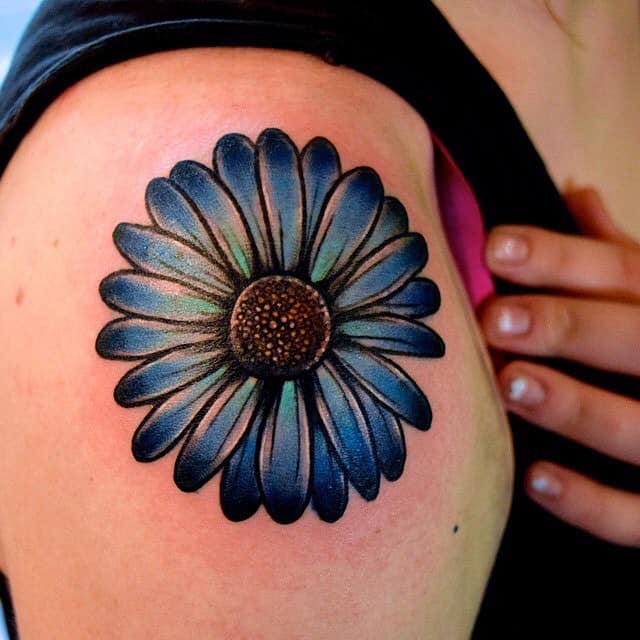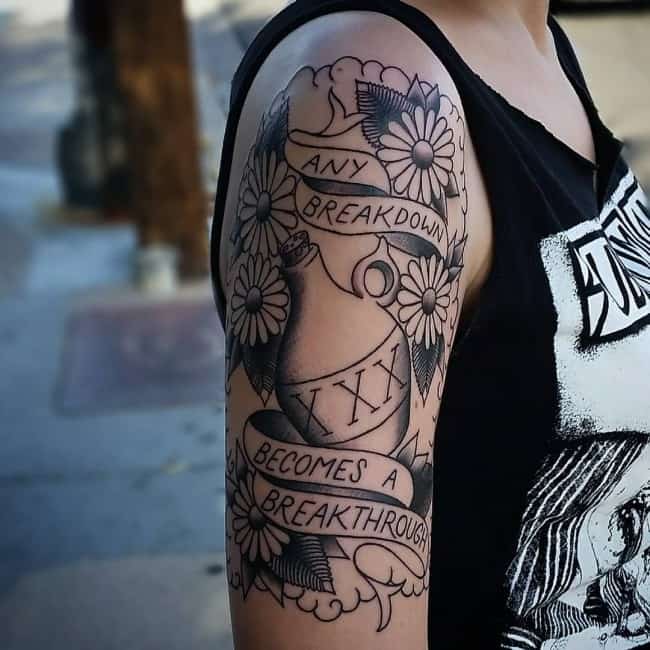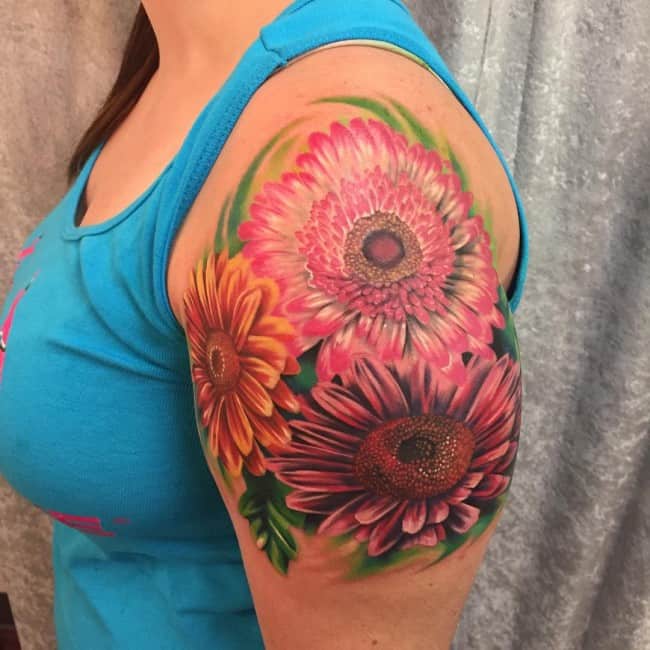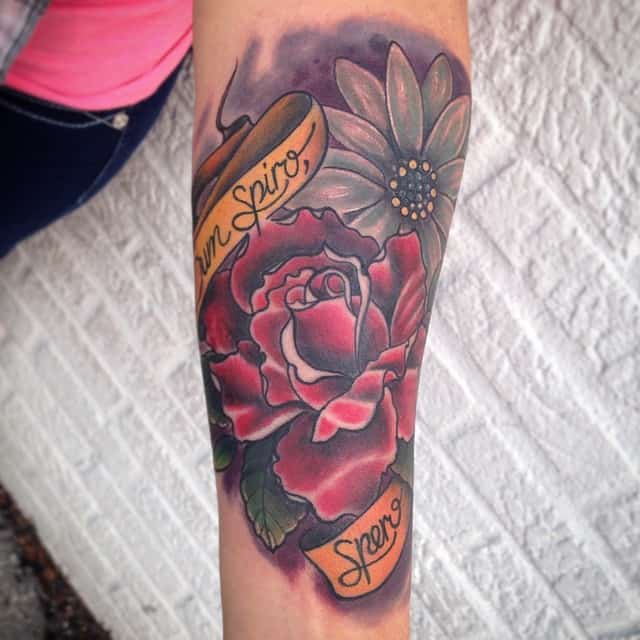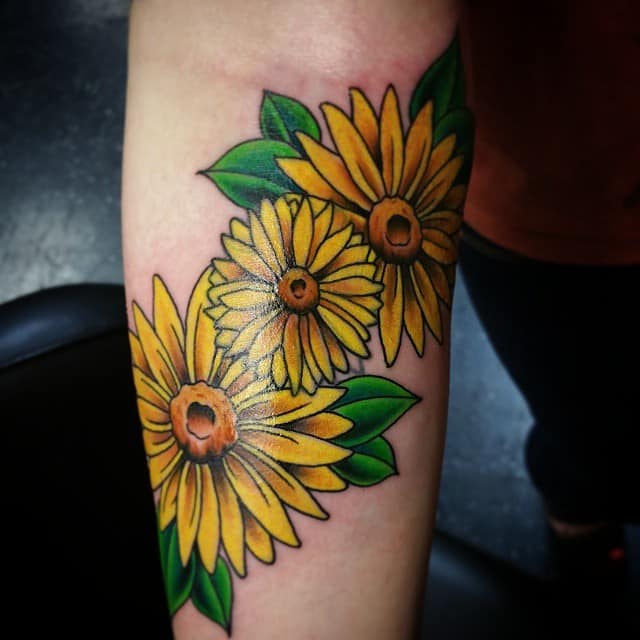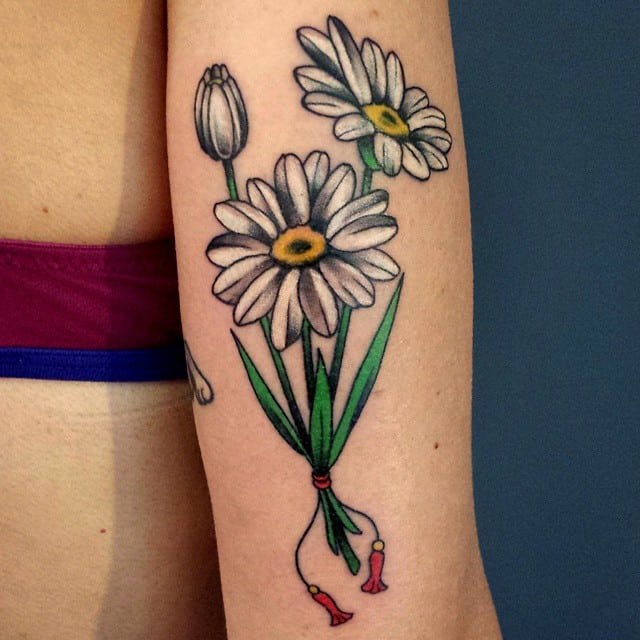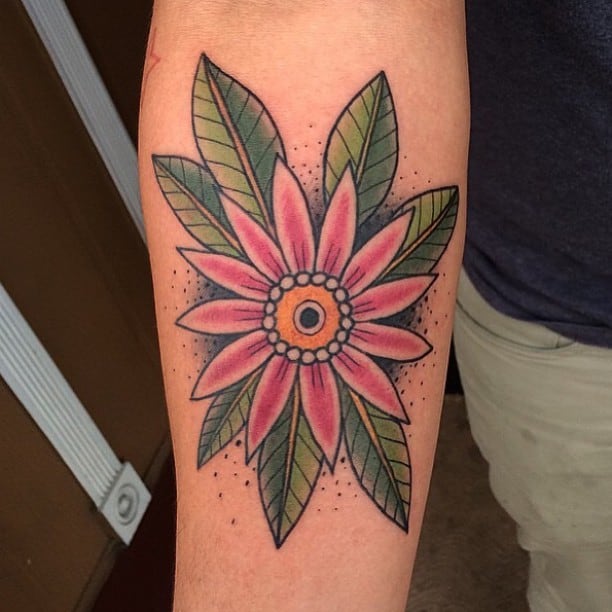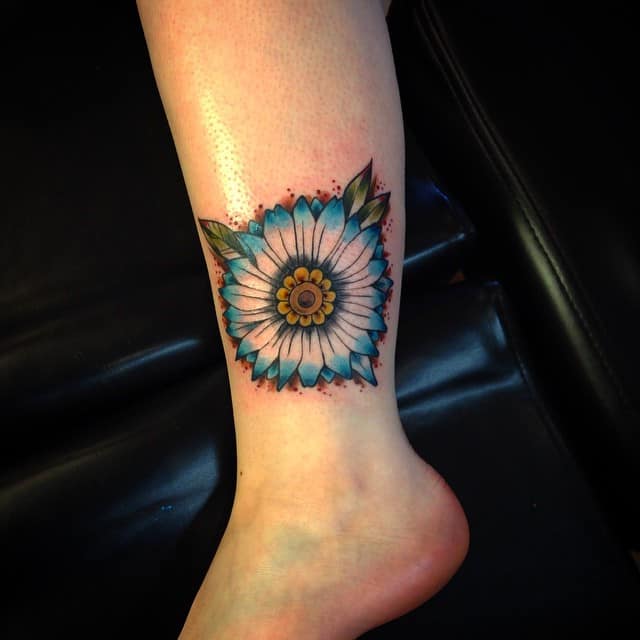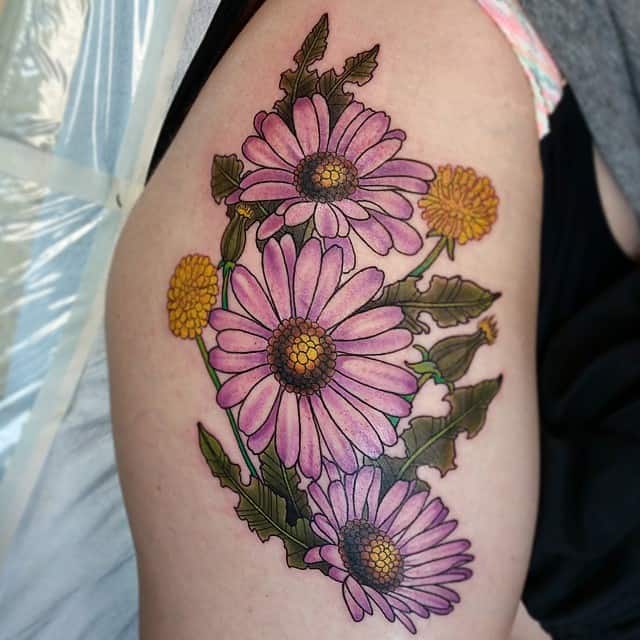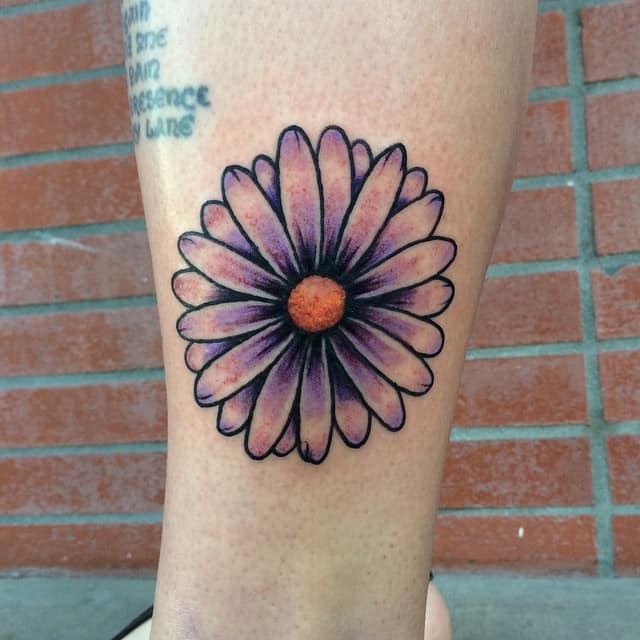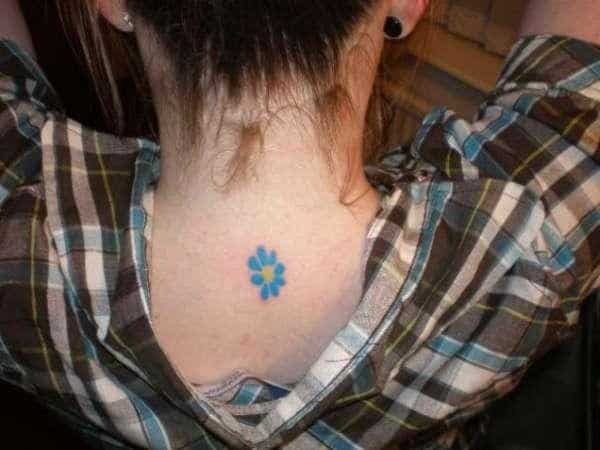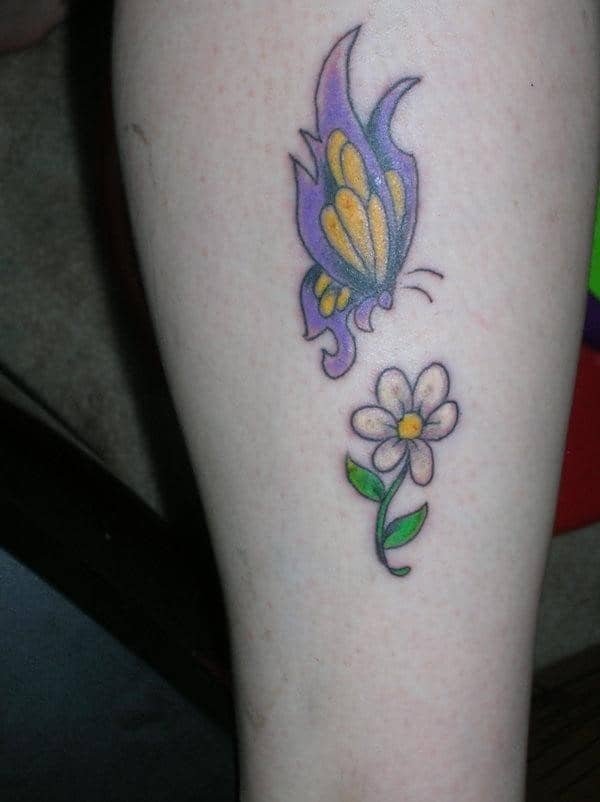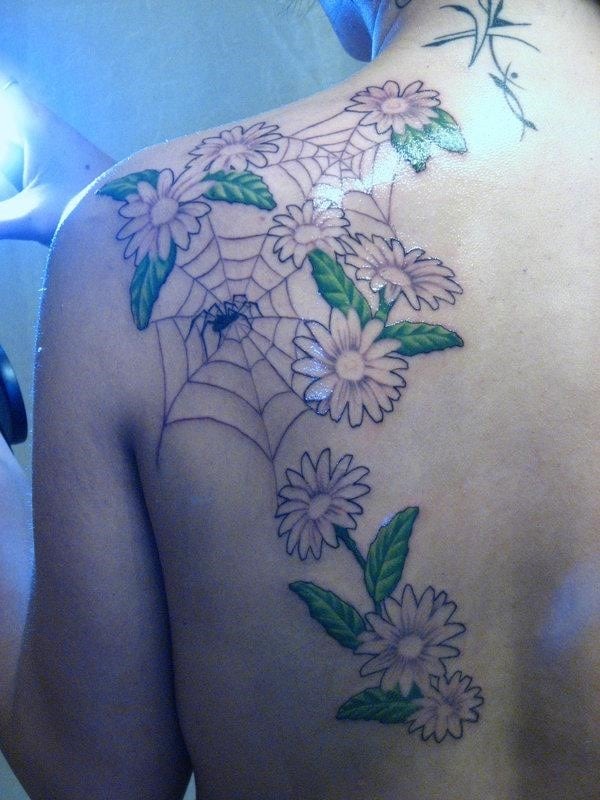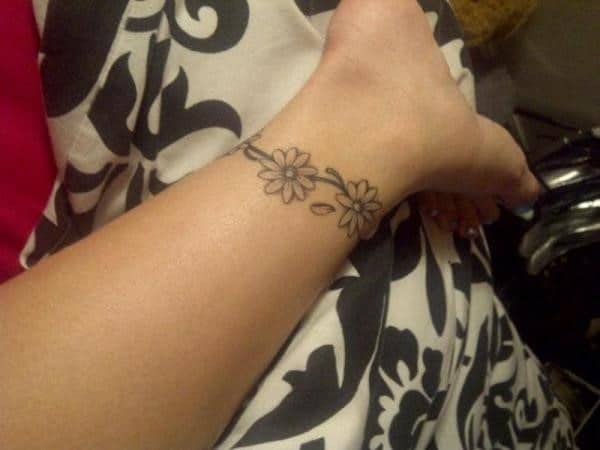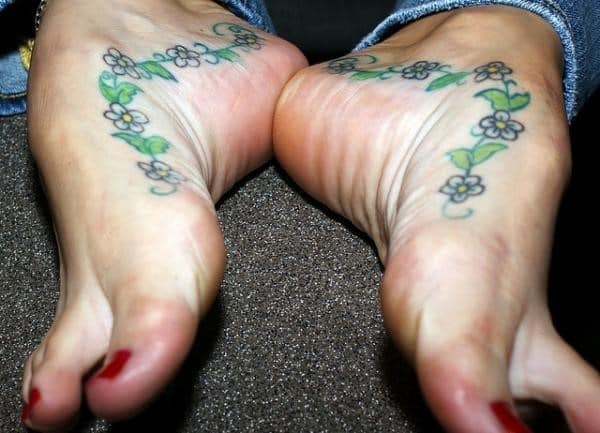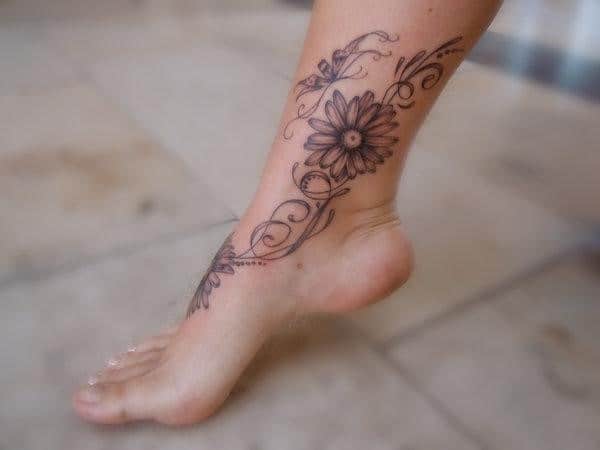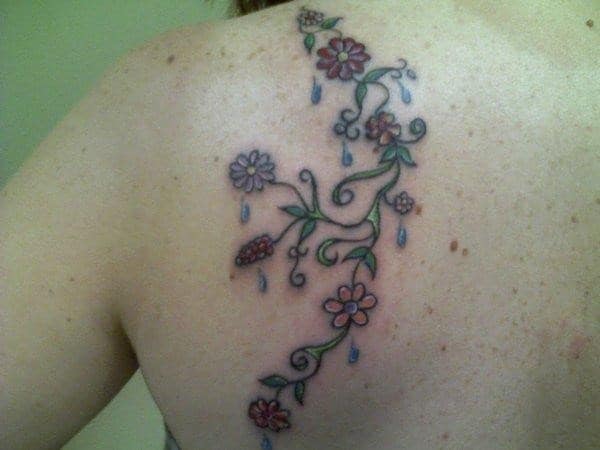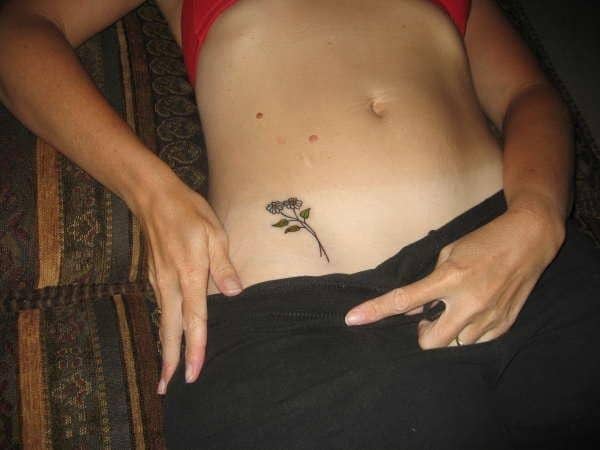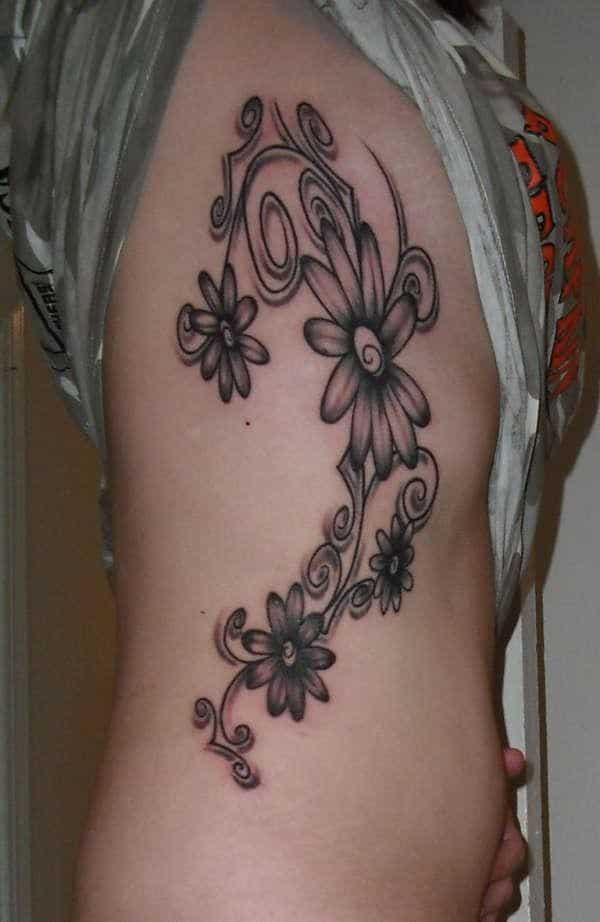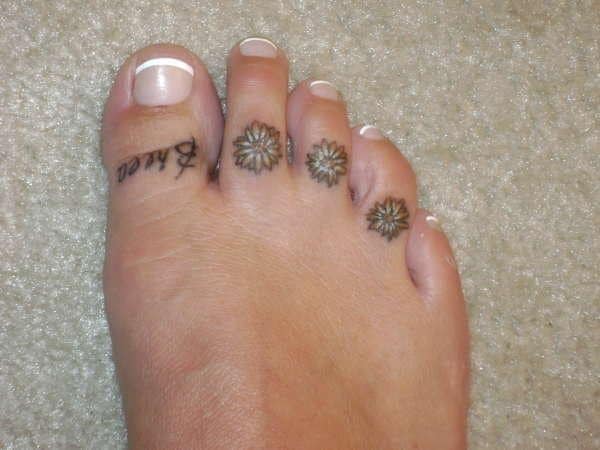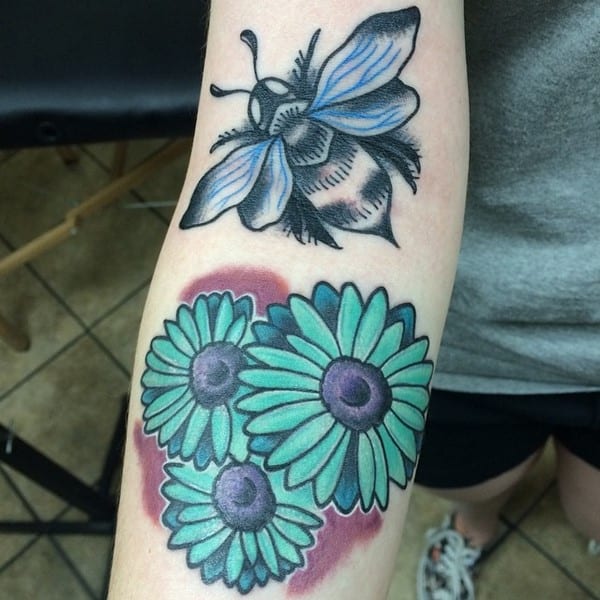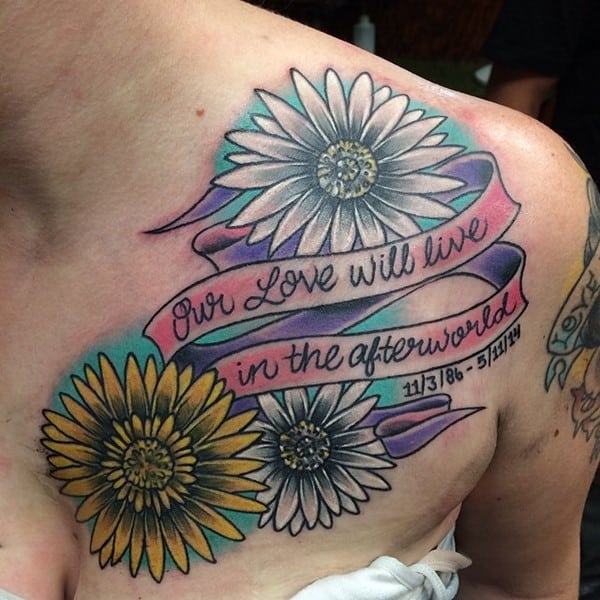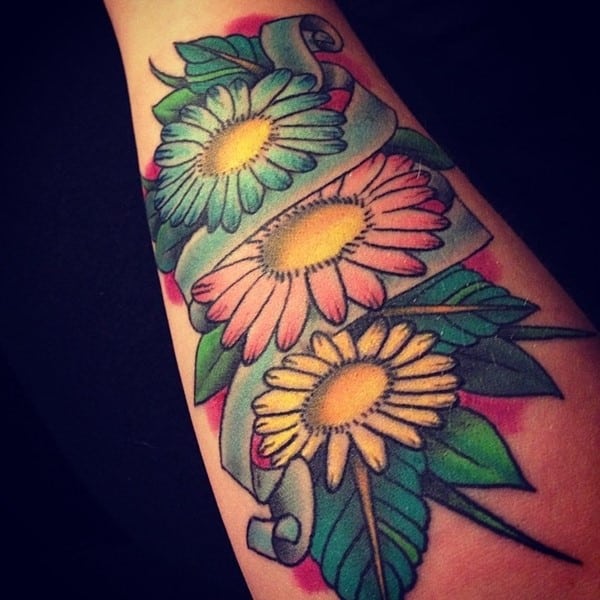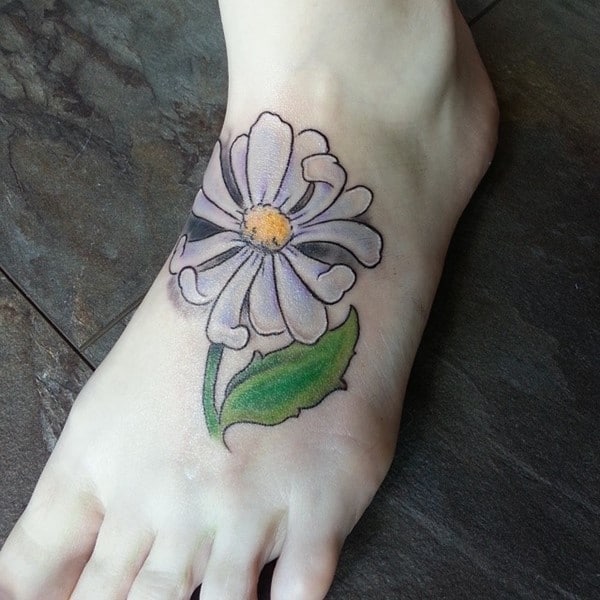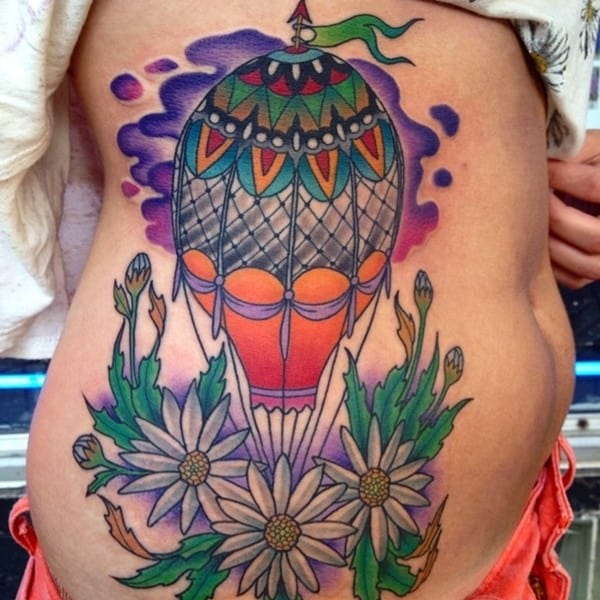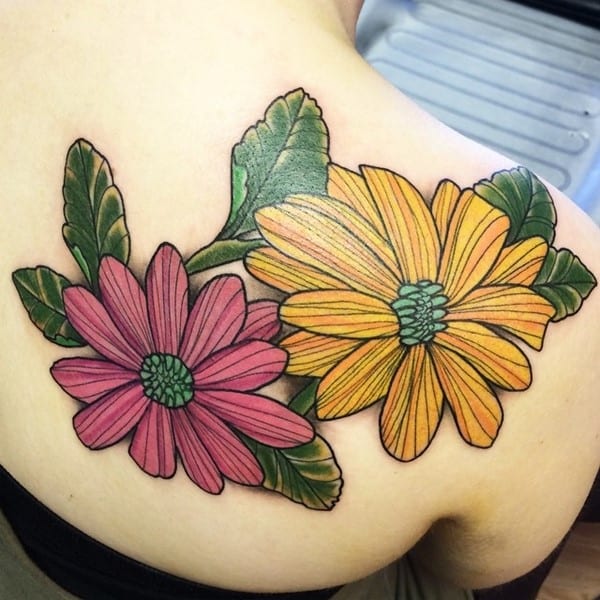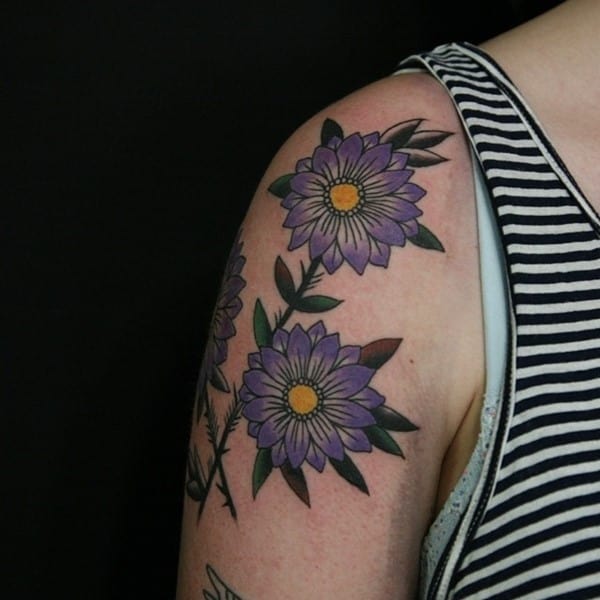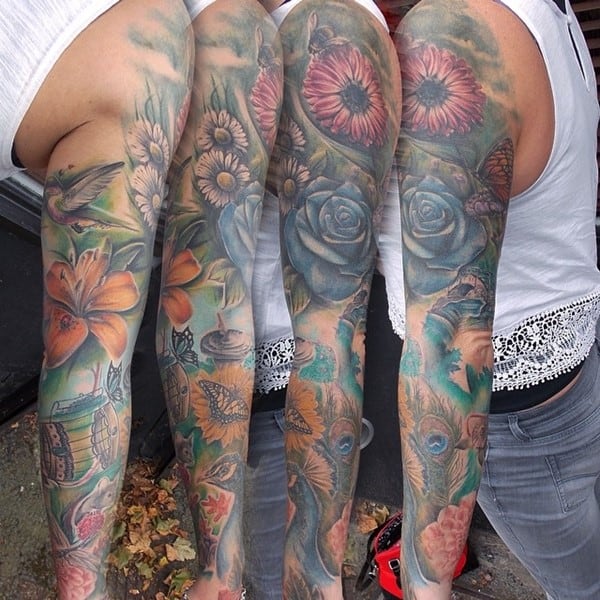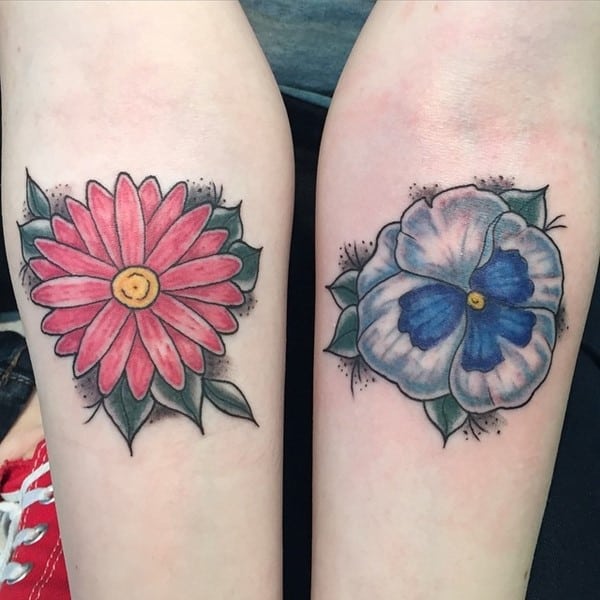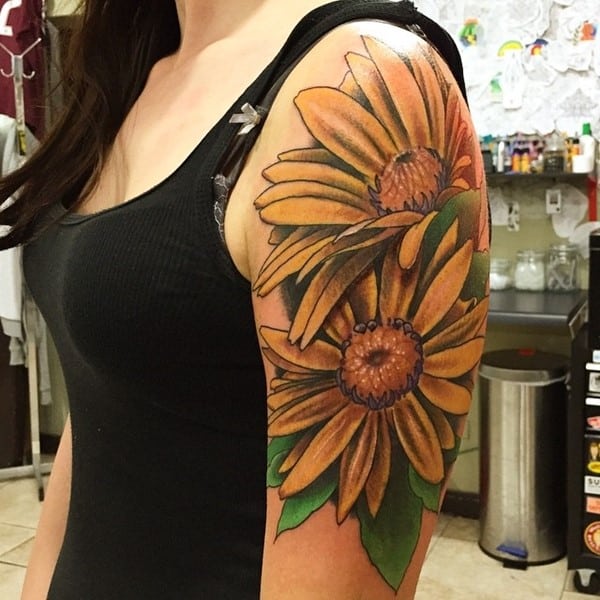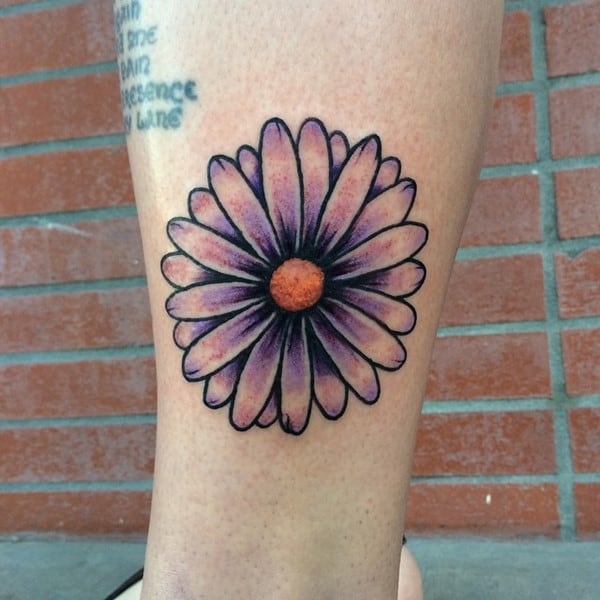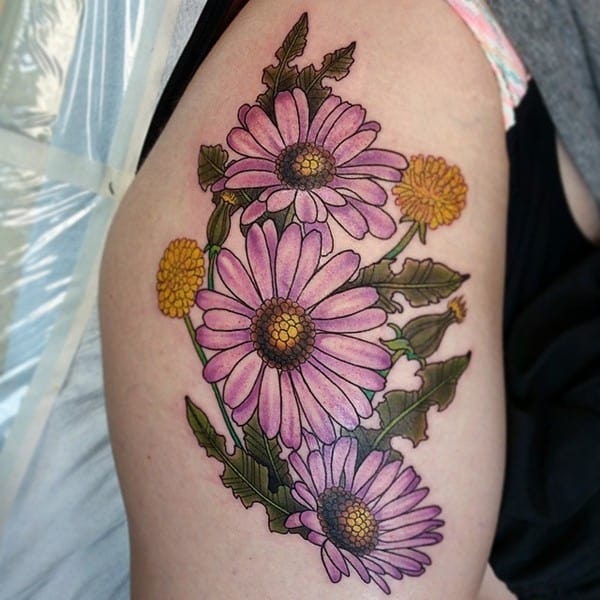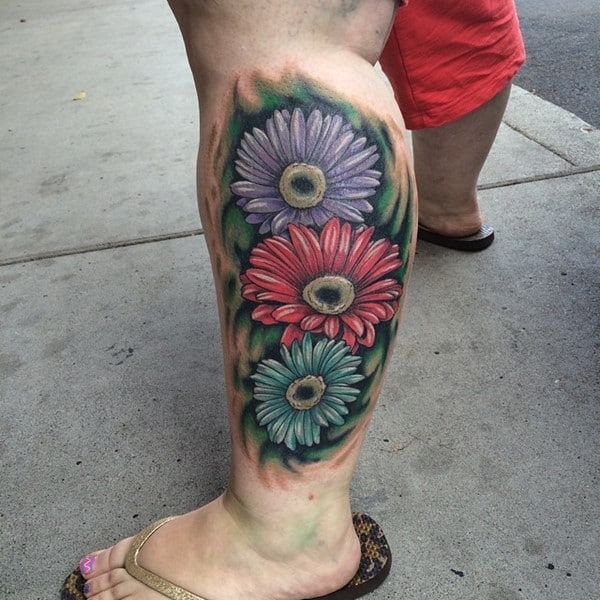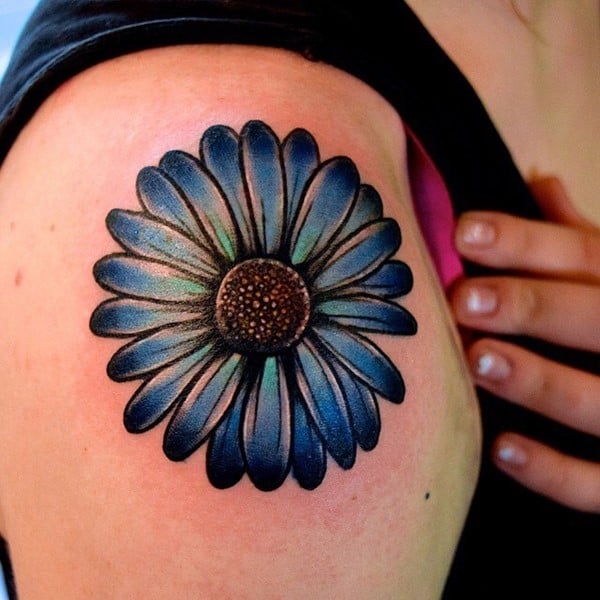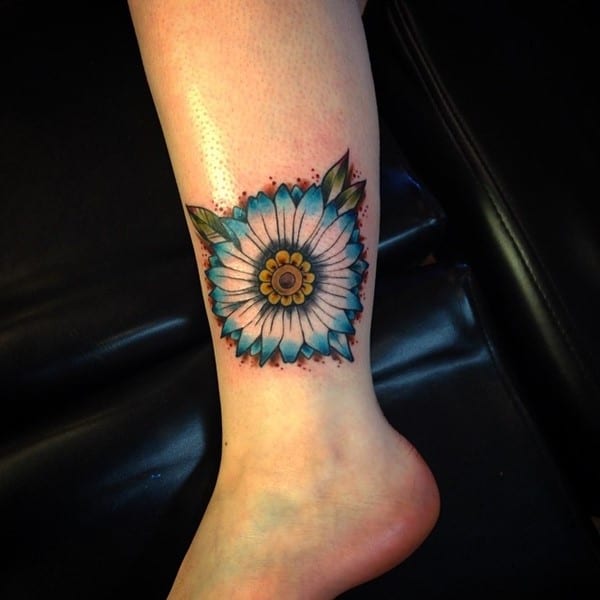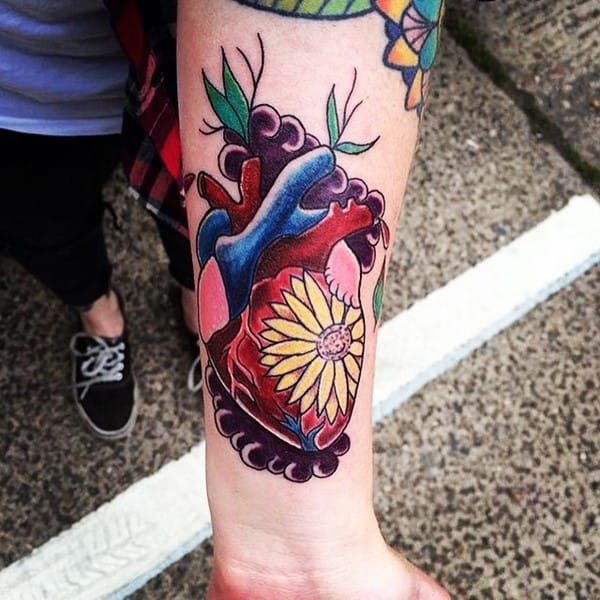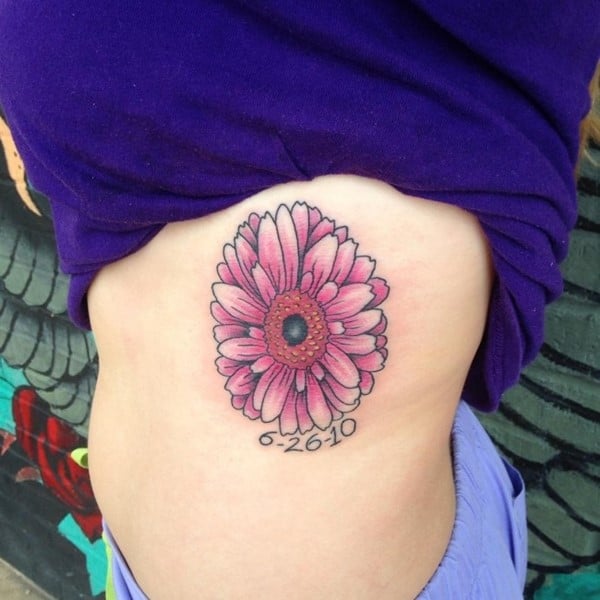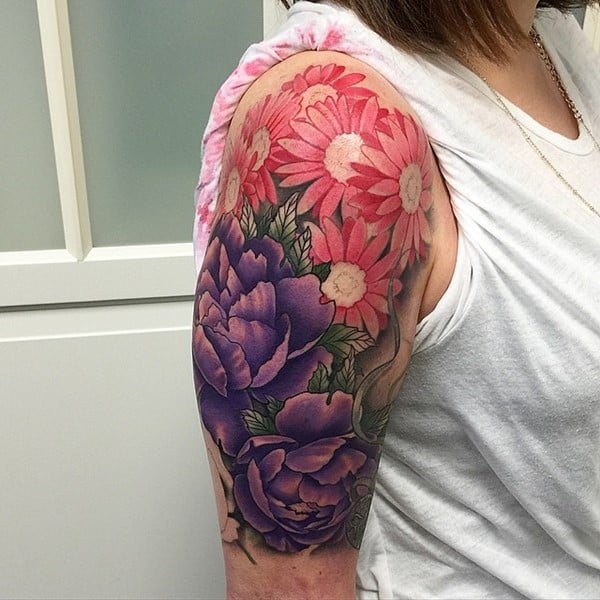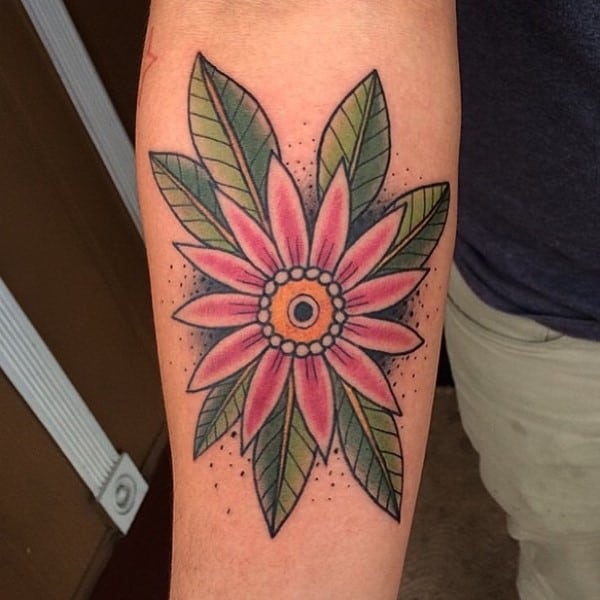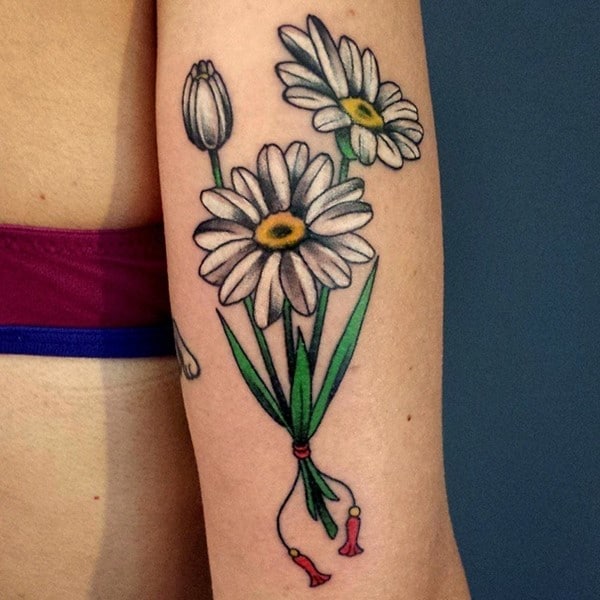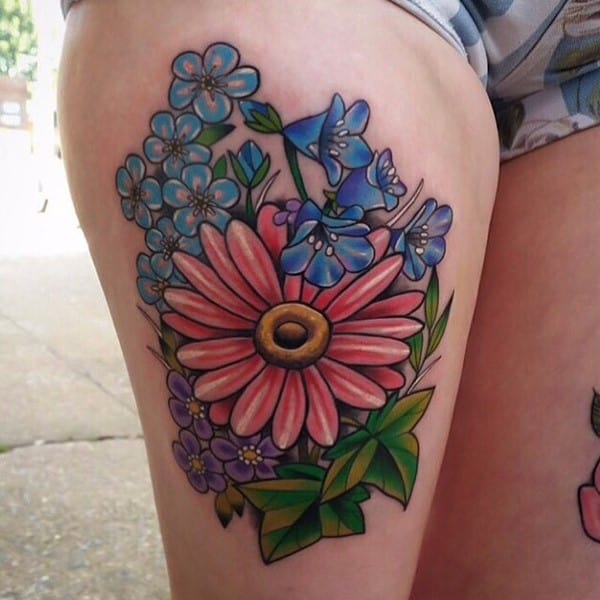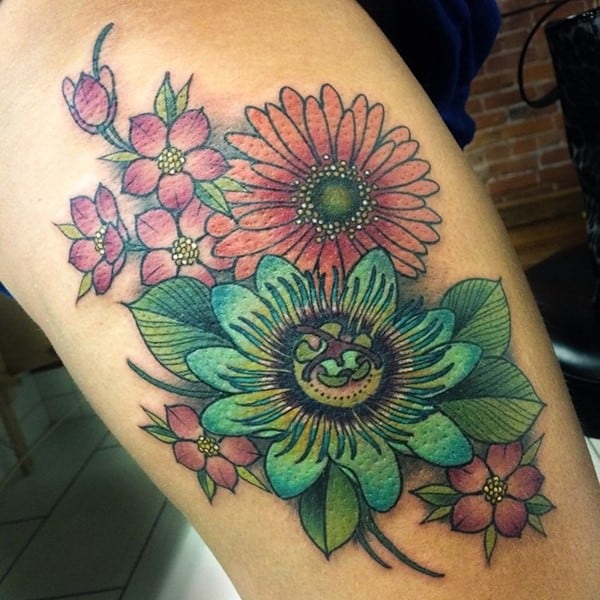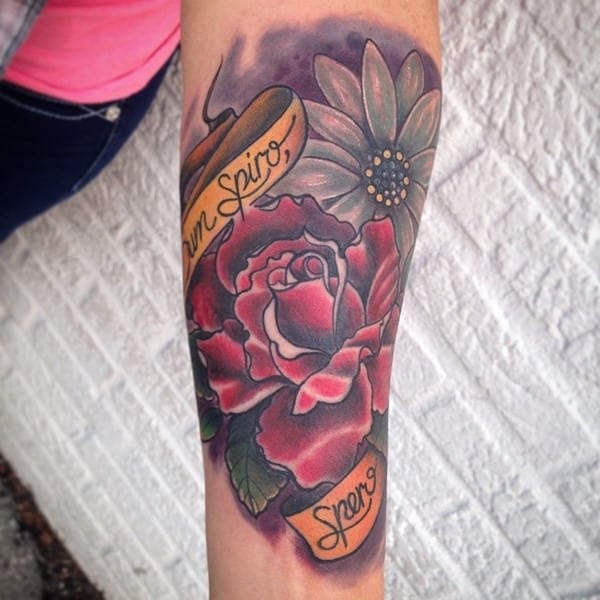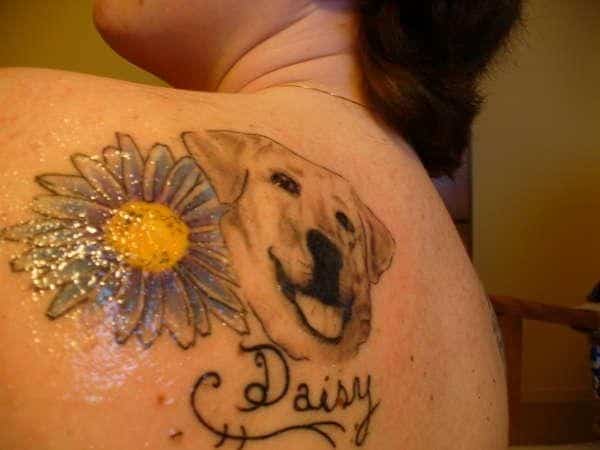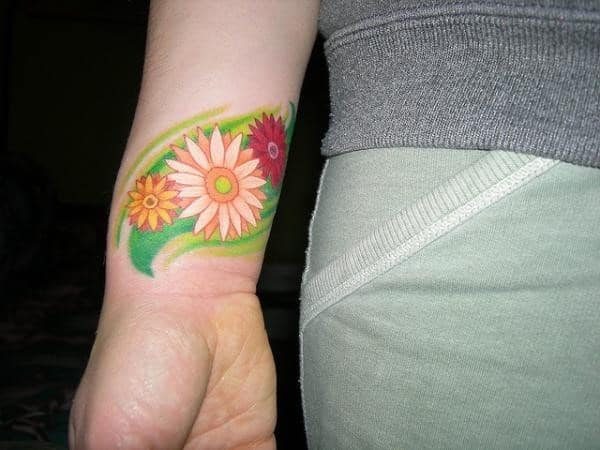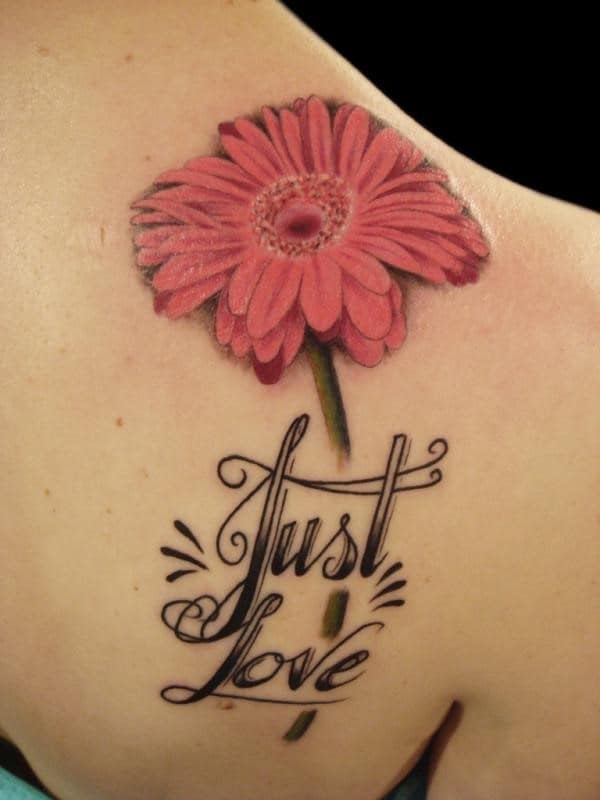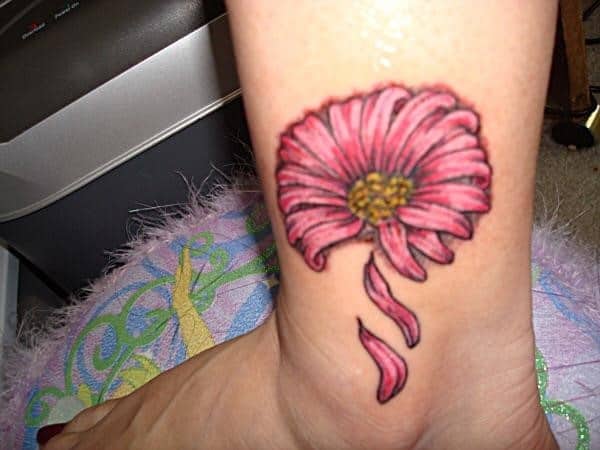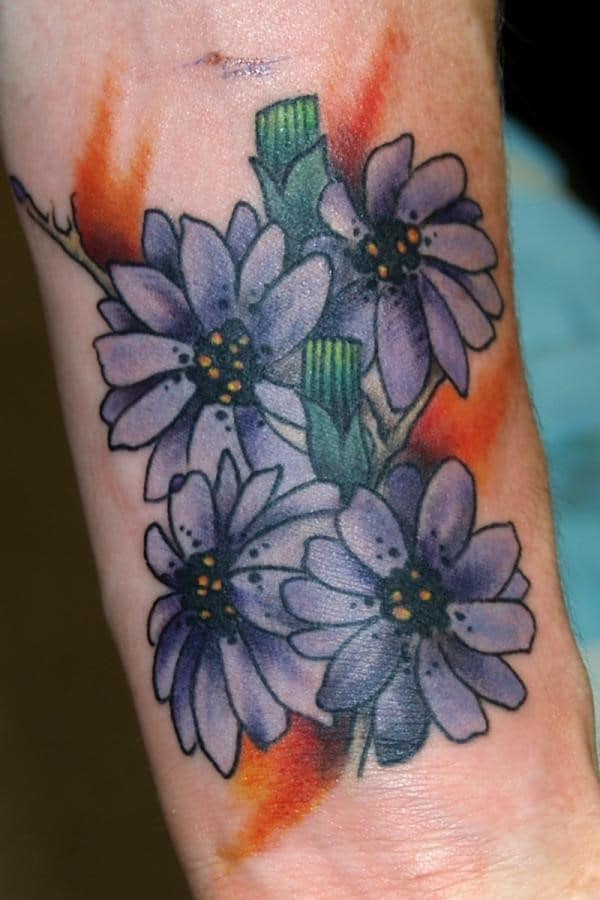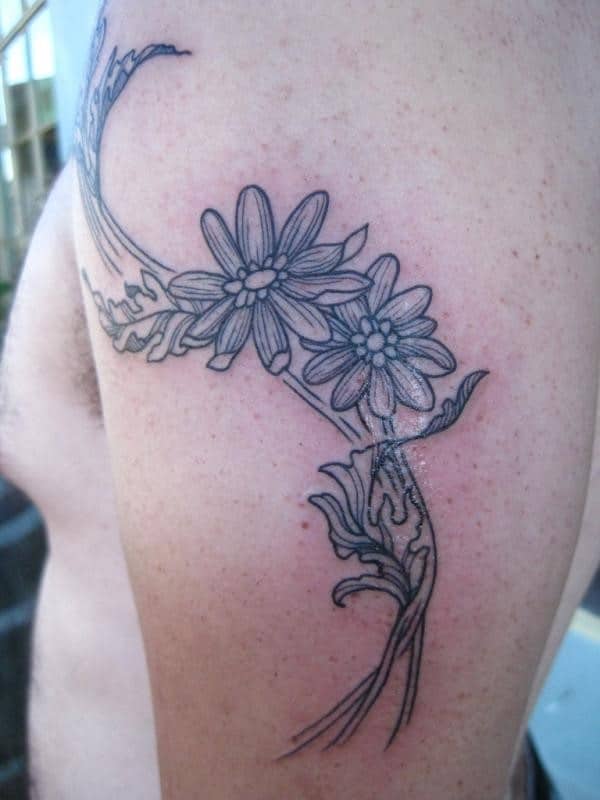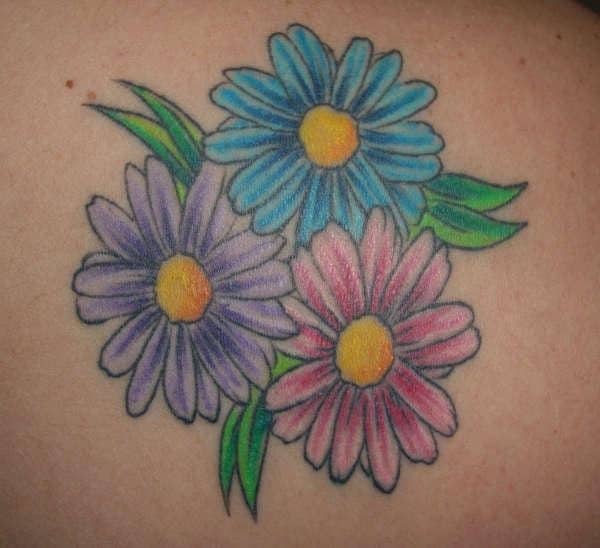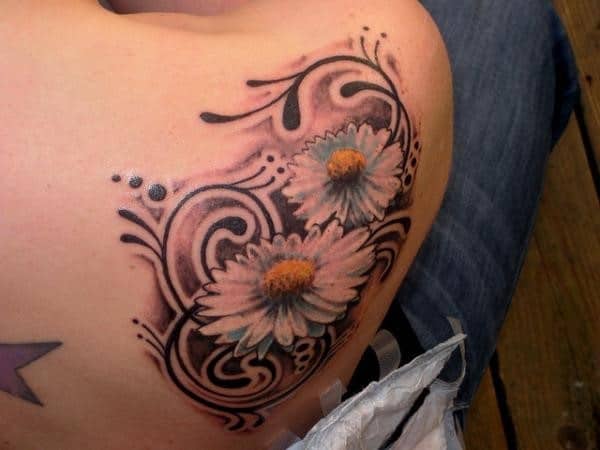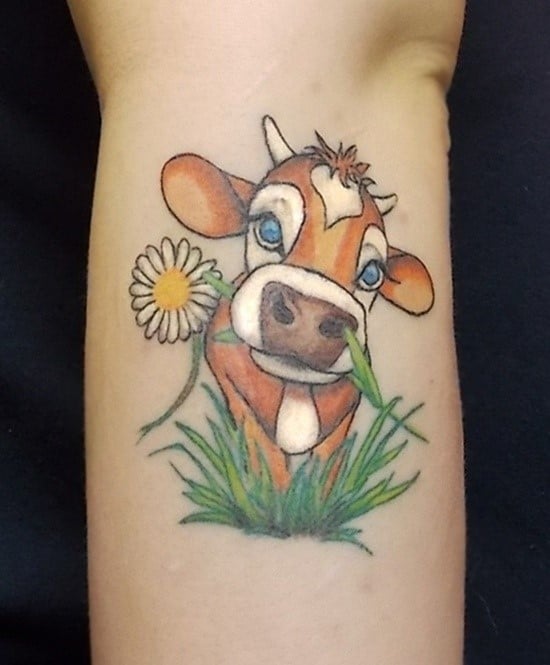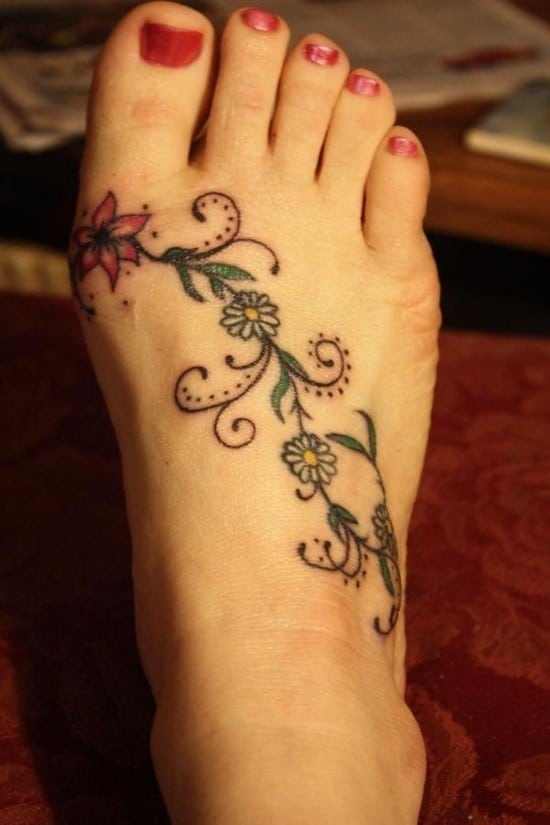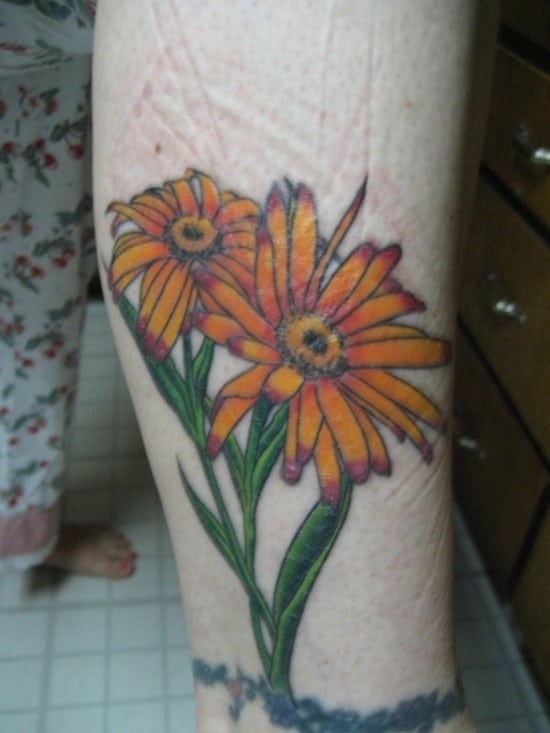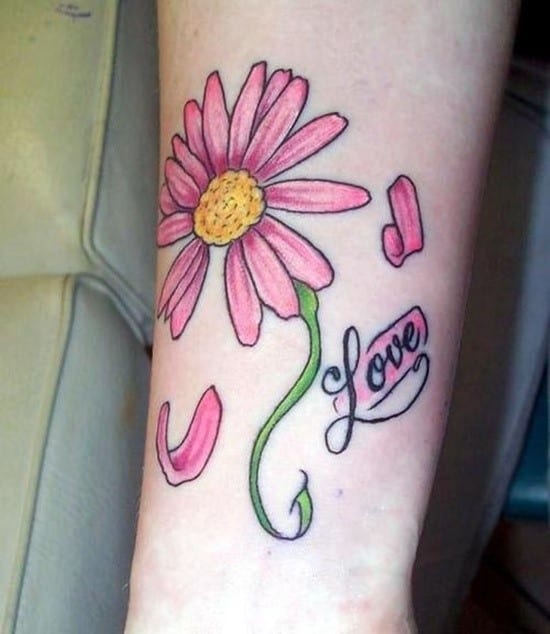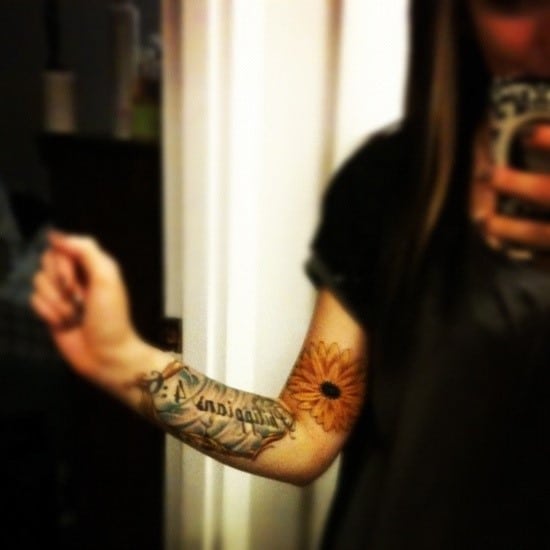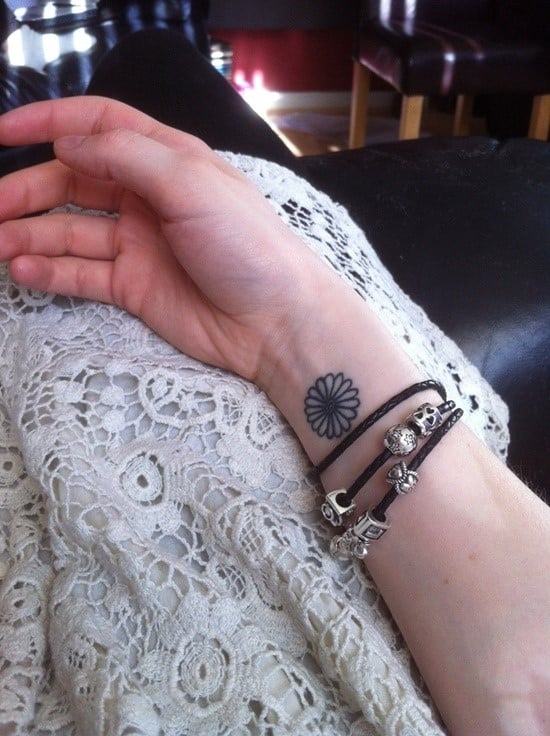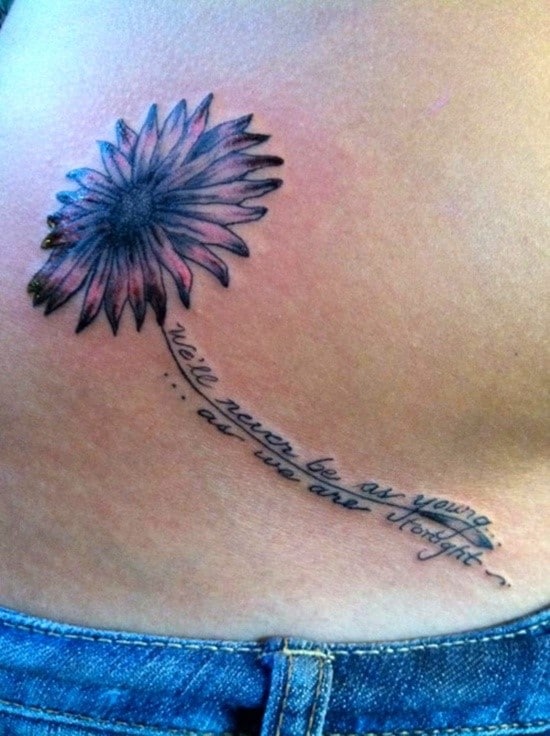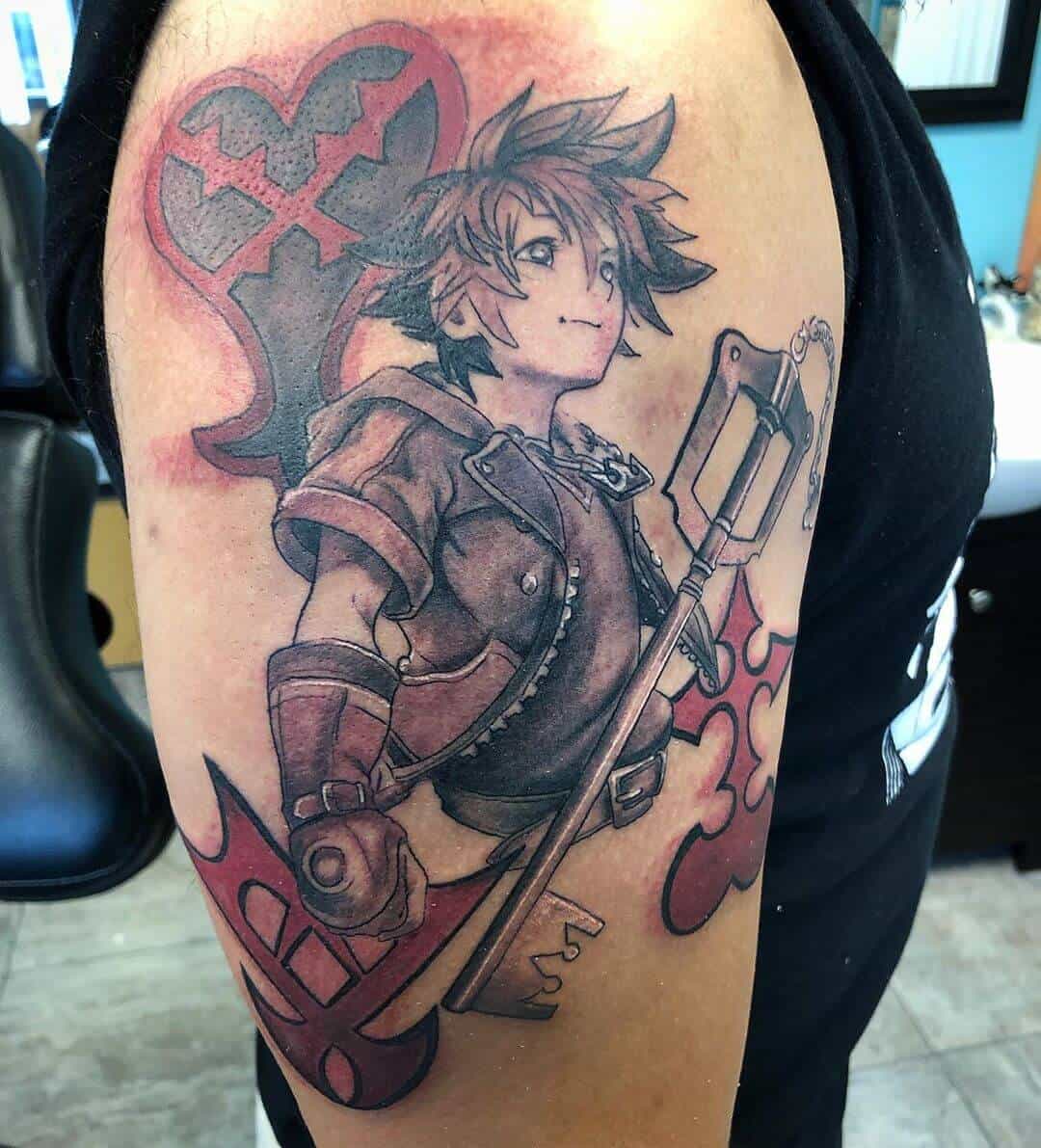Alongside roses and lotuses, daisies are one of the most popular kinds of flower for tattoo designs.
These simple, delicate flowers appear in tattoos on their own or as part of larger designs and have a range of cultural and symbolic meanings.
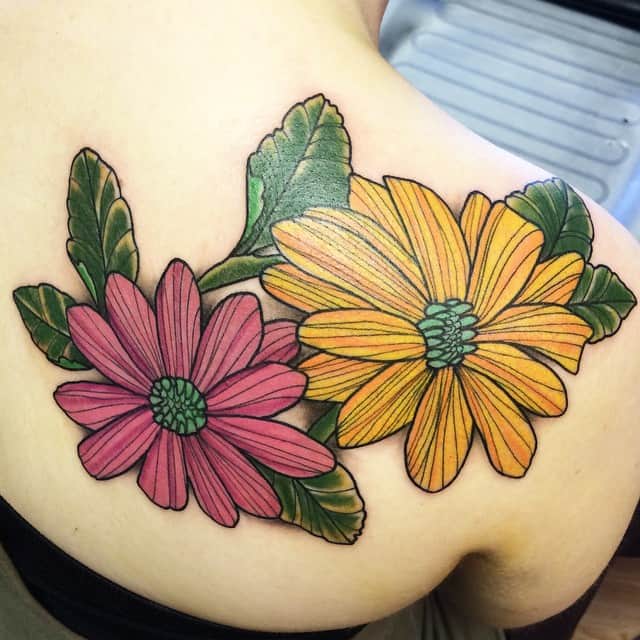
When most people think of daisies, they imagine a small flower with a yellow center and white petals.
This is the common daisy (Bellis perennis), found primarily in Europe, North America and Africa.
Colorful flowers that look very similar to common daisies are known as gerbera (or gerber) daisies.
They’re significantly larger than the common variety and come in a range of colors, from yellow and orange to pink and dark red.
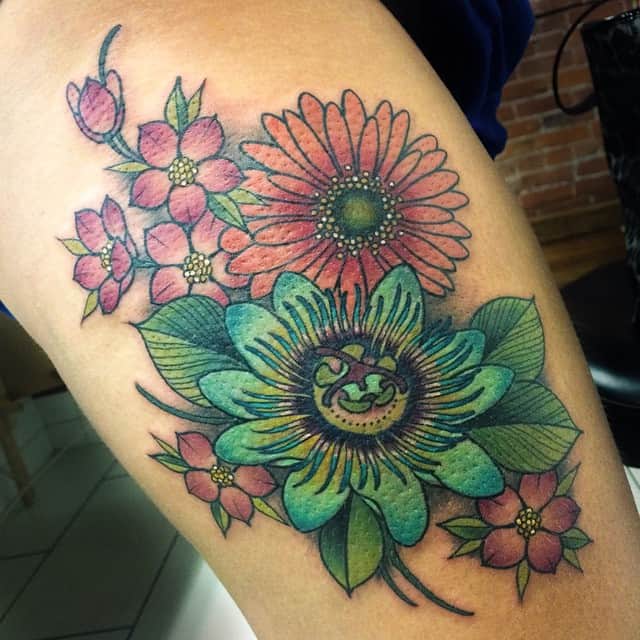
Daisy tattoo meaning
Like most symbols, daisies have several meanings and associations, depending on the culture and period in question. The most significant meanings of daisies include:
- Purity and innocence – this is particularly true of common (white) daisies with yellow centers. The simplicity and pale coloring of the flower is likely the reason behind this association, though some sources suggest that this meaning comes from a Celtic legend, according to which god sprinkled daisies over the earth whenever an infant died. During the Renaissance period, daisies were associated with the Virgin Mary in Christian cultures, further adding to the association between this flower and the notion of purity.
- Beauty – the scientific name of the common daisy comes from words meaning ‘everlasting beauty’ in Latin.
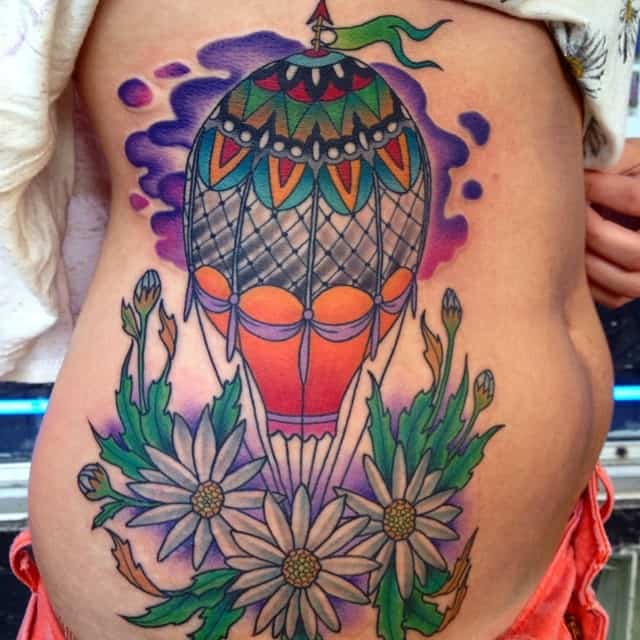
- True love – daisies are composite flowers, which means they’re actually made up of two separate flowers – the yellow one in the center (disc floret) and the white outer one (ray floret). Because of the way that these two elements are both complementary and inseparable, daisies are sometimes associated with couples, soul mates, and true love. There was also a superstition suggesting that placing daisy petals under your pillow would bring dreams of love.
- New beginnings – this meaning likely stems from Norse mythology. The daisy was the symbol of Freya – the Norse goddess of love, beauty, and fertility. Nowadays, daisies are often found in bouquets for new mothers.
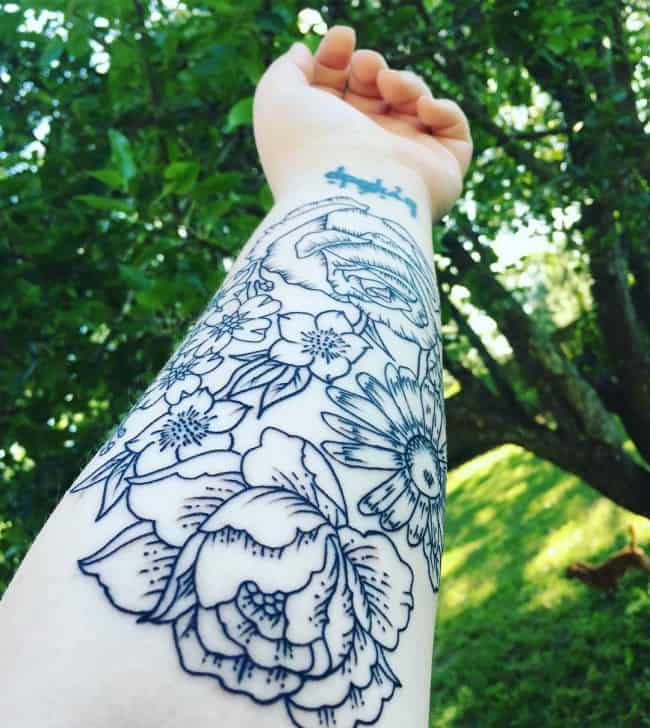
- Transformation – this one comes from the Roman myth of Vertumnus and Belides. Belides was a nymph (a mythological spirit of nature), and Vertumnus was the god of seasons and gardens. When Vertumnus fell in love with Belides, she rejected his advances. In order to avoid him, she transformed herself into a daisy.
Daisy color meanings
Another layer of meaning can be added to a daisy themed tattoo through the use of color. Though common daisies are only ever white, gerbera daisies come in several color varieties, including:
- Yellow – the color yellow generally symbolizes joy, happiness, and friendship. Yellow gerbera daisy tattoos are therefore the perfect way to express how important friendship is to you. They also work great as matching friendship tattoos.
- Orange – like yellow, orange is a symbol of joy – but also of creativity and emotional energy.
- Pink – pink daisies symbolize gentleness and romance, as well as being associated with feminine energy.
- Red – red daisies are symbolic of love and passion.
Many people opt for a gerber daisy tattoo with mixed colors, for instance, one flower of each color arranged in a single design.
This kind of tattoo could be purely decorative, or it could be used to express the importance of all of the values expressed by the different colors – purity, joy, creativity, and love.
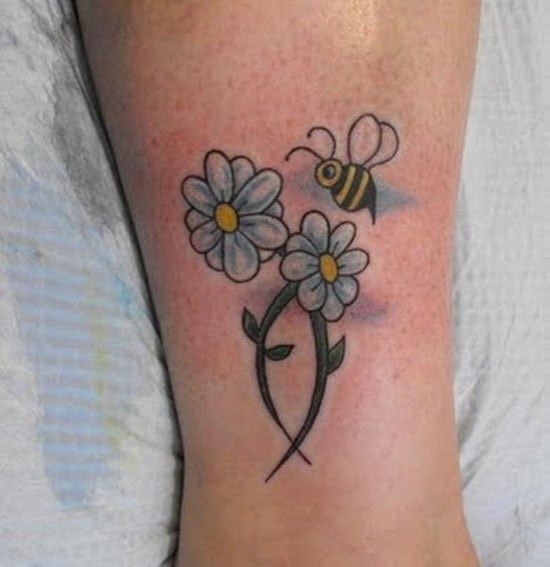
Daisies in Victorian flower messages
In Victorian times, flower arrangements and bouquets had very specific meanings.
Certain flowers were used to secretly deliver messages that were too unconventional or difficult to speak aloud or deliver in writing. There was, therefore, something of a code associated with flowers.
The flowers themselves had a meaning, as did the ribbons used to tie the arrangement and even in the way that they were delivered.
For example, giving flowers to someone using your right hand could be code for ‘yes’, in answer to a question.
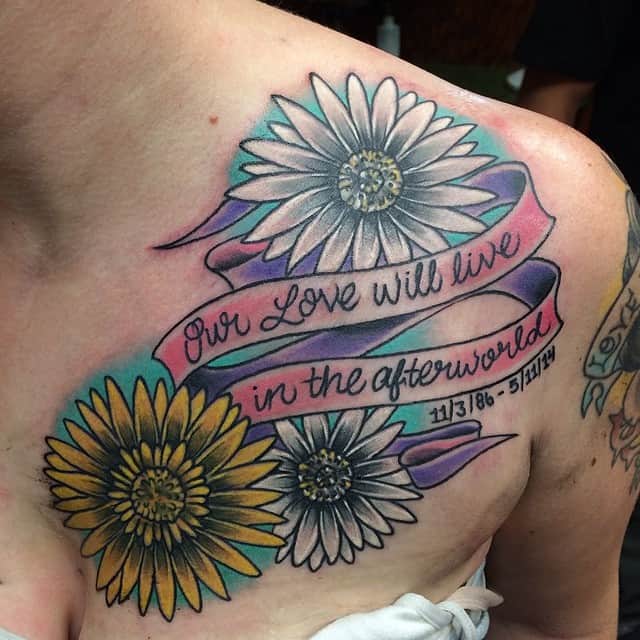
In this ‘system’, common (white) daisies symbolized innocence and purity. Gerber (colorful) daisies were associated with cheerfulness and were often paired with ferns – the symbol of sincerity.
Asters (Michaelmas daisies), a small, blue variety of daisies, was used to signify farewell or departure.
It’s interesting to note that if the flowers were upside down, they were meant to symbolize the opposite of their usual meaning.
So while upright common daisies symbolized innocence, given upside down they could have meant guilt.
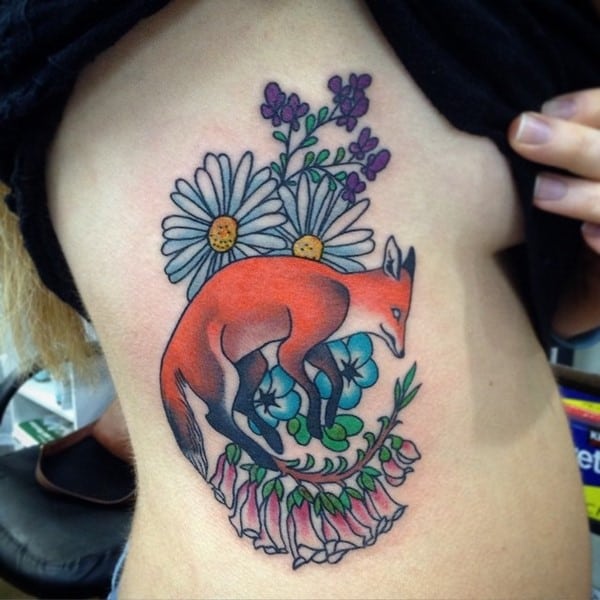
Popular daisy tattoo designs
Traditional daisy tattoo
Tattoos in the traditional style – with a black outline and solid fill – appear to be the top choice for daisy-themed tattoos.
Colorful gerbera daisies work best for this style, as the use of vibrant colors is one of the defining characteristics of this aesthetic.
Black outline daisy tattoo
In the past couple of years, tattoos of flowers in the form of only thin black outlines have become a highly popular choice.
This makes for an intricate, elegant design that works best as a medium- to large-sized piece, usually placed on the forearm.
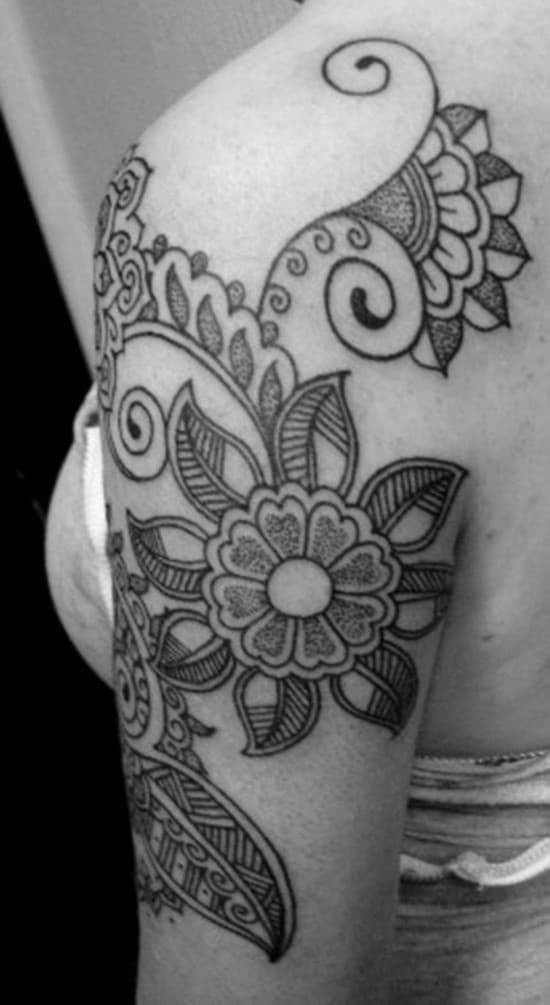
Watercolor daisy tattoo
Once again, colorful gerbera daisies work best for this design. The watercolor style results in fluid, lighter coloring that aims to resemble a free-form watercolor painting.
Watercolor tattoos can be tough to get right, though, so make sure your chosen tattoo artist is experienced in this style.
Daisy tattoo with writing
If your daisy style tattoo is intended to have specific personal meaning, you may want to highlight its significance through adding writing. Quotes, names, and dates are all great choices.
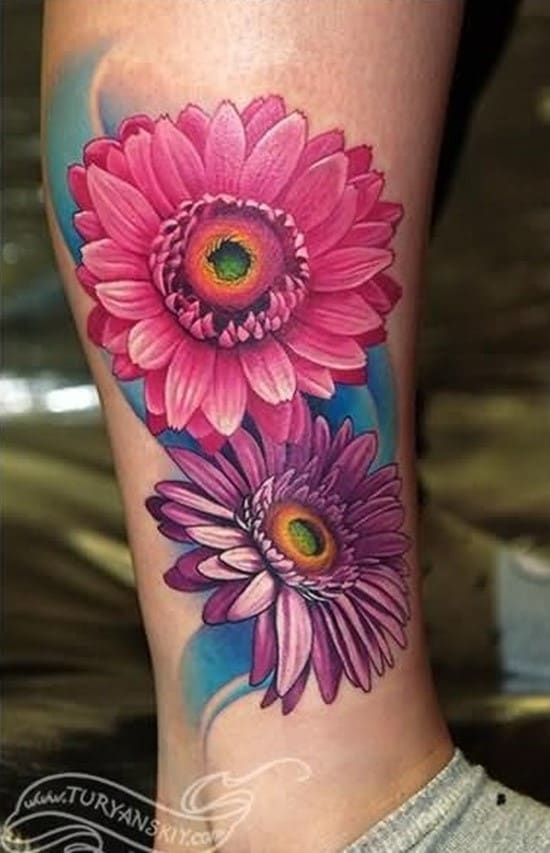
Daisies and other design elements
Apart from writing, there’s a whole range of suitable elements you could add to your daisy tattoo design to make it more complex and appealing.
Among the most popular choices are insects – butterflies, ladybirds, and bees. All of these have a close connection to flowers in nature, which means that they work great as complimentary design elements for daisies.
Butterflies are a symbol of life, hope, and change. Many cultures associate them with transformation and resurrection due to their life cycle – butterflies start out as caterpillars before transforming into beautiful winged creatures.
Ladybirds are believed to bring good luck, fortune, and prosperity. They’re associated with having an inquisitive nature and high spirits.
Bees symbolize community and productivity, as well as determination and energy.
Daisy chain tattoo
A daisy chain is a string of daisies tied together by their stems. Though making daisy chains is generally associated with children nowadays, some sources suggest that Medieval knights would wear daisy chains into battle.
The chains were made by their significant others as a token of love and protection.
Daisy chains are a great choice for an armband tattoo – wrapping all the way around the wrist or arm like a bracelet.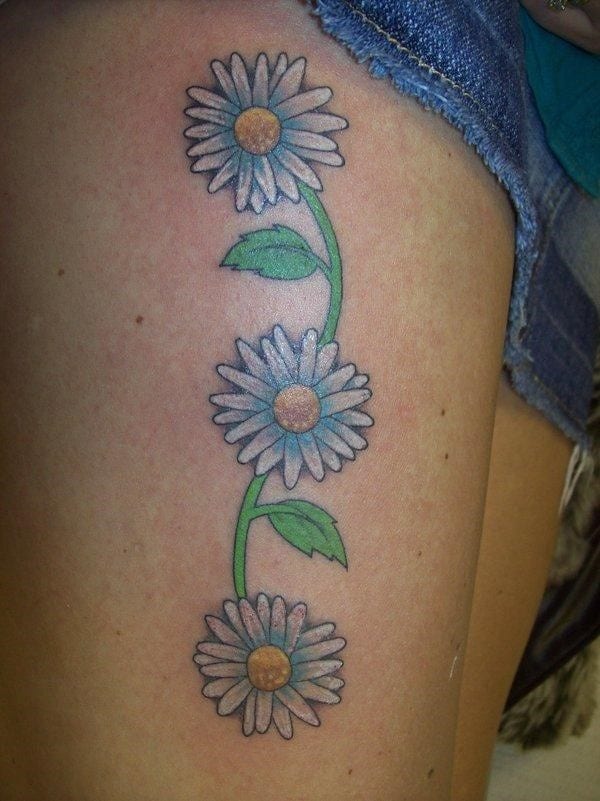
A daisy without some of its petals
A tattoo with a daisy missing some of its petals is often a reference to the game ‘He/she loves me, he/she loves me not’, in which hopeful girls and guys pick off the petals of a daisy one by one, alternately saying the phrases ‘loves me’ and ‘loves me not’ at each petal.
The phrase said when picking off the very last petal is supposed to determine whether the object of their affection returns their feelings.
In one variation of this game, the person would then close their eyes and pick up a handful of daisies without looking. The number of flowers picked up was supposed to signify the number of years until marriage.
The specific meaning of a design like this will be very personal – for some it can symbolize unrequited love or lost love, for others lifelong affection for someone or an important relationship.
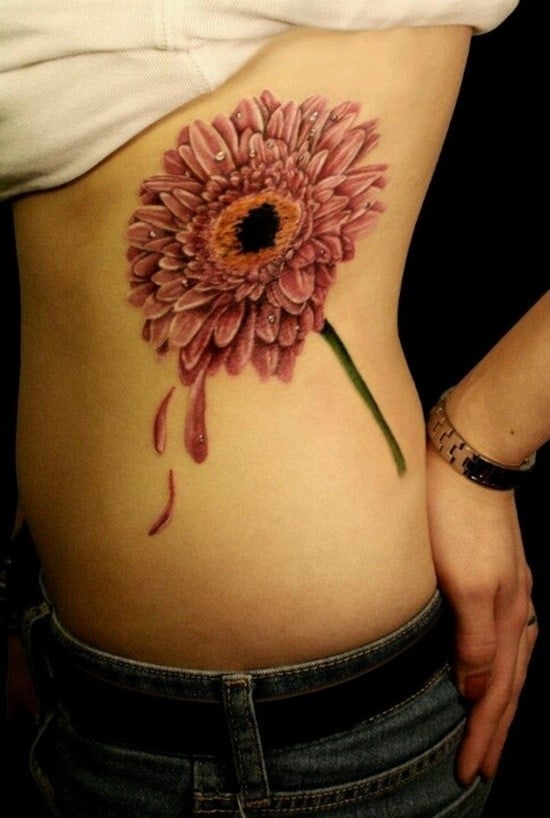
Daisy tattoo placements
As with most tattoos, the size and level of detail of a design will influence your choice of placement. Daisies are relatively simple elements, meaning they can be scaled down to very small sizes – small enough to fit on your finger or earlobe.
For medium-sized daisy tattoo designs that involve more color and detail, your choice of placement will naturally be limited to larger areas of the body. For instance, arms, legs, and the back of the neck are all large enough spaces for medium tattoos. Sleeves and half-sleeves involving daisy designs are also an interesting option.
Large tattoos need a large space – such as your back, chest, or thigh. Keep in mind that large tattoos are proportionately more expensive and take much longer to finish – a full back tattoo takes between 20-30 hours to complete.
When choosing a tattoo placement, it’s important to also consider whether you want your tattoo to be in plain view at all times. Daisy tattoos are of course highly unlikely to be offensive in themselves, but there is still a level of social stigma associated with tattoos in some circles.
Tattoos on the side of the neck, on your hands, top of the chest, and forearms are going to be visible most of the time and may be troublesome to cover up if necessary. Conversely, back, shoulder, or thigh tattoos will be hidden by your clothing most of the time anyway and won’t be difficult to conceal.
